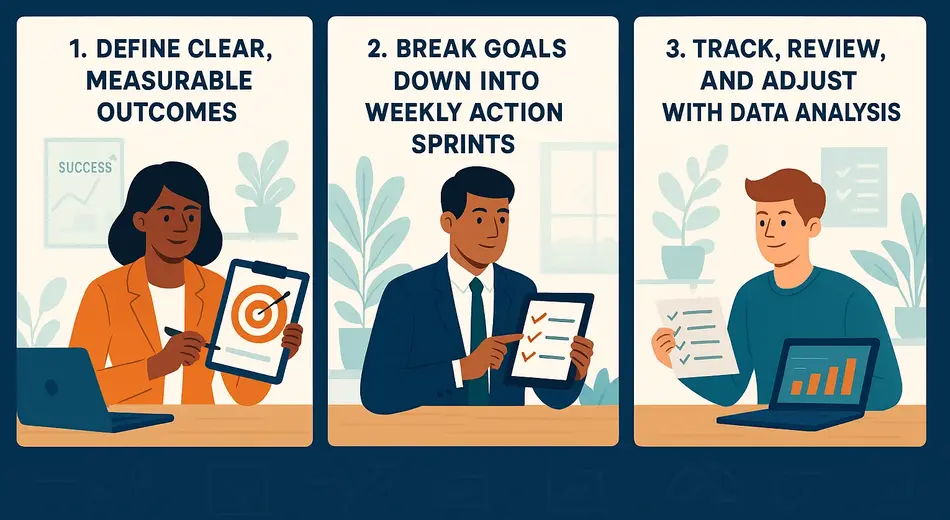The Science Behind Effective Goal Setting
In today’s fast-paced world, effective goal setting has become more crucial than ever for personal and professional success. When properly structured, goals serve as powerful cognitive mechanisms that direct attention, mobilize effort, and increase persistence—three critical factors in achieving any worthwhile objective.
The Three Pillars of Effective Goal Setting
1. Create Time-Bound and Specific Objectives
The cornerstone of effective goal setting is specificity combined with clear timeframes. As the transcript emphasizes: “Make your goal time bound and specific so that when you reach that time, someone can ask you, ‘Have I achieved your goal?’ And you have to answer yes or no. There’s no gray area.”
To transform ambiguous wishes into achievable goals:
- Define exactly what success looks like in measurable terms
- Establish a specific deadline for achievement
- Create criteria that make evaluation black and white
- Eliminate subjective language that allows for interpretation
- Use the SMART framework to structure your objectives
When your goal has these elements, you create what psychologists call “implementation intention”—a mental trigger that automatically activates goal-directed behaviors when certain situations arise.
2. Frame Goals in Positive Terms
The second principle of effective goal setting involves the psychological framing of your objectives. The transcript highlights this important aspect: “Make sure you frame your goals in the positive. Most people set goals because they want to avoid things. They don’t like their job. They don’t like where they live. Think about all the great things that will happen as a consequence of you achieving that goal.”
Research from positive psychology demonstrates why positive framing works better:
- Positive goals activate the brain’s reward centers, releasing dopamine that reinforces goal-directed behavior
- Avoidance-based goals trigger stress responses that deplete mental energy
- Positive framing keeps you focused on opportunities rather than threats
- Achievement-oriented language creates stronger visualization of success
- Positive goals build intrinsic motivation rather than fear-based compliance
To apply positive framing to your effective goal setting practice, ask yourself: “What will I gain from achieving this goal?” rather than “What will I avoid?”
3. Establish Strategic Sub-Goals
The transcript emphasizes this third crucial principle: “Make sure you have sub goals. Sometimes the goal is really hairy and long-term. Make sure you have some sub goals along the way that you can measure. Make them the same, specific, and time bound.”
Even the most well-defined goals can seem overwhelming when they involve significant change or long timeframes. This is where the third principle of effective goal setting becomes essential: breaking larger objectives into strategic sub-goals.
When creating sub-goals as part of your effective goal setting strategy:
- Ensure each sub-goal directly contributes to the main objective
- Make sub-goals follow the same specific, time-bound format
- Space sub-goals appropriately to maintain momentum
- Create clear connections between sub-goals and the larger purpose
- Track progress visually to maintain motivation
The Flexibility Principle: When to Adapt Your Goals
While persistence is valuable, true effective goal setting also requires knowing when to adapt or abandon goals that no longer serve you. As the transcript notes: “If your life changes, the goal is no longer relevant, just let that goal go and do it in a way that doesn’t hold you back. So you can focus on the next goal.”
Signs It’s Time to Reassess Your Goals
Recognizing when to adapt your goals is itself an important skill. Consider reassessing when:
- The fundamental assumptions behind your goal have changed
- Pursuing the goal creates significant harm in other life areas
- You’ve gained new information about better alternatives
- Your core values or priorities have legitimately shifted
- The external environment has changed dramatically
- The goal was based on someone else’s expectations rather than your authentic desires
Implementing Effective Goal Setting in Different Life Domains
The principles of effective goal setting apply universally but manifest differently across various life domains.
Career Advancement Goals
When setting professional development goals:
- Align personal objectives with organizational priorities
- Create development plans with both skill and relationship components
- Establish metrics that matter to decision-makers in your field
- Break advancement goals into visible achievement milestones
- Seek regular feedback from mentors on goal relevance
- Explore job opportunities that align with your career goals
Personal Development Goals
For personal growth objectives:
- Connect habit changes to deeper values and identity
- Create environmental triggers that support new behaviors
- Build accountability systems with appropriate social support
- Schedule regular reflection on progress and meaning
- Balance challenge goals with maintenance goals
FAQ: Effective Goal Setting
What makes specific, time-bound goals more effective than general aspirations?
Specific, time-bound goals are fundamental to effective goal setting because they create clear parameters for success. When goals include concrete metrics and deadlines, they activate implementation intentions in the brain—automatic mental triggers that prompt specific actions when certain conditions arise. Research shows that vague goals like “do my best” produce significantly lower performance than specific targets like “complete 10 quality reports by Friday.” The specificity eliminates ambiguity about what constitutes success, allowing your brain to focus resources more efficiently on relevant tasks.
Why is positive framing so important in effective goal setting?
Positive framing is crucial for effective goal setting because it aligns with how our motivation systems function optimally. Goals framed as pursuing positive outcomes activate the brain’s reward circuitry, releasing dopamine that reinforces goal-directed behavior. In contrast, avoidance-based goals trigger stress responses that deplete mental energy over time. Studies demonstrate that individuals who focus on what they want to achieve rather than what they want to avoid maintain higher motivation, experience less psychological resistance, and report greater satisfaction throughout the goal pursuit process.
How do sub-goals contribute to successful goal achievement?
Sub-goals are essential components of effective goal setting because they transform distant objectives into manageable steps that provide regular feedback and motivation. Psychologically, humans struggle with delayed gratification over extended periods. Sub-goals create a “progress principle” effect—the satisfaction of regular achievements that maintains motivation during long-term pursuits. Research indicates that people who break larger goals into structured sub-goals with their own deadlines and success criteria are approximately 33% more likely to persist through challenges and ultimately achieve their primary objective.
When is it appropriate to abandon or modify a previously set goal?
Knowing when to adapt goals is a sophisticated aspect of effective goal setting that many people overlook. Goals should be reassessed when fundamental assumptions change, when pursuit creates significant harm in other life areas, or when core values shift meaningfully. The key distinction is between abandoning goals due to normal resistance (which undermines growth) versus intentionally pivoting when goals no longer align with your authentic priorities or reality. Effective goal-setters regularly review their objectives, asking whether each goal still represents the best use of their limited resources and attention.






